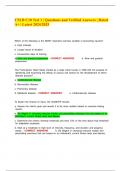Exam (elaborations)
CSLB C10 Test 1 | Questions and Verified Answers | Rated A+ | Latest 2024/2025
CSLB C10 Test 1 | Questions and Verified Answers | Rated A+ | Latest 2024/2025CSLB C10 Test 1 | Questions and Verified Answers | Rated A+ | Latest 2024/2025CSLB C10 Test 1 | Questions and Verified Answers | Rated A+ | Latest 2024/2025CSLB C10 Test 1 | Questions and Verified Answers | Rated A+ | Lat...
[Show more]
Preview 4 out of 190 pages
Uploaded on
October 23, 2024
Number of pages
190
Written in
2024/2025
Type
Exam (elaborations)
Contains
Questions & answers
Institution
CSLB C10
Course
CSLB C10
$14.99
100% satisfaction guarantee
Immediately available after payment
Both online and in PDF
No strings attached
CSLB C10 Test 1 | Questions and Verified Answers | Rated




